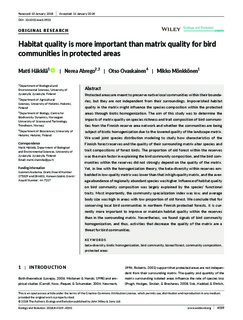| dc.contributor.author | Hakkila, Matti | |
| dc.contributor.author | Abrego, Nerea | |
| dc.contributor.author | Ovaskainen, Otso | |
| dc.contributor.author | Monkkonen, Mikko | |
| dc.date.accessioned | 2019-09-06T09:22:16Z | |
| dc.date.available | 2019-09-06T09:22:16Z | |
| dc.date.created | 2018-11-24T21:05:32Z | |
| dc.date.issued | 2018 | |
| dc.identifier.citation | Ecology and Evolution. 2018, 8 (8), 4019-4030. | nb_NO |
| dc.identifier.issn | 2045-7758 | |
| dc.identifier.uri | http://hdl.handle.net/11250/2612902 | |
| dc.description.abstract | Protected areas are meant to preserve native local communities within their boundaries, but they are not independent from their surroundings. Impoverished habitat quality in the matrix might influence the species composition within the protected areas through biotic homogenization. The aim of this study was to determine the impacts of matrix quality on species richness and trait composition of bird communities from the Finnish reserve area network and whether the communities are being subject of biotic homogenization due to the lowered quality of the landscape matrix. We used joint species distribution modeling to study how characteristics of the Finnish forest reserves and the quality of their surrounding matrix alter species and trait compositions of forest birds. The proportion of old forest within the reserves was the main factor in explaining the bird community composition, and the bird communities within the reserves did not strongly depend on the quality of the matrix. Yet, in line with the homogenization theory, the beta‐diversity within reserves embedded in low‐quality matrix was lower than that in high‐quality matrix, and the average abundance of regionally abundant species was higher. Influence of habitat quality on bird community composition was largely explained by the species' functional traits. Most importantly, the community specialization index was low, and average body size was high in areas with low proportion of old forest. We conclude that for conserving local bird communities in northern Finnish protected forests, it is currently more important to improve or maintain habitat quality within the reserves than in the surrounding matrix. Nevertheless, we found signals of bird community homogenization, and thus, activities that decrease the quality of the matrix are a threat for bird communities. | nb_NO |
| dc.language.iso | eng | nb_NO |
| dc.publisher | Wiley | nb_NO |
| dc.rights | Navngivelse 4.0 Internasjonal | * |
| dc.rights.uri | http://creativecommons.org/licenses/by/4.0/deed.no | * |
| dc.title | Habitat quality is more important than matrix quality for bird communities in protected areas | nb_NO |
| dc.type | Journal article | nb_NO |
| dc.type | Peer reviewed | nb_NO |
| dc.description.version | publishedVersion | nb_NO |
| dc.source.pagenumber | 4019-4030 | nb_NO |
| dc.source.volume | 8 | nb_NO |
| dc.source.journal | Ecology and Evolution | nb_NO |
| dc.source.issue | 8 | nb_NO |
| dc.identifier.doi | 10.1002/ece3.3923 | |
| dc.identifier.cristin | 1634590 | |
| dc.description.localcode | This is an open access article under the terms of the Creative Commons Attribution License, which permits use, distribution and reproduction in any medium, provided the original work is properly cited. © 2018 The Authors | nb_NO |
| cristin.unitcode | 194,66,10,0 | |
| cristin.unitname | Institutt for biologi | |
| cristin.ispublished | true | |
| cristin.fulltext | original | |
| cristin.qualitycode | 1 | |

